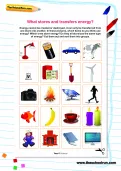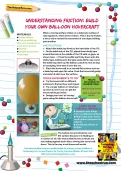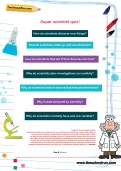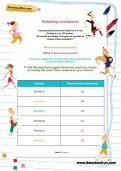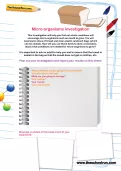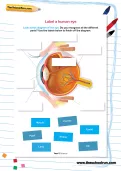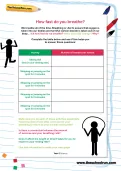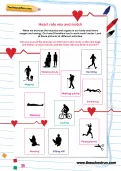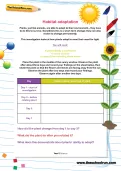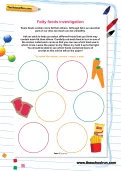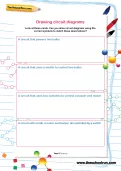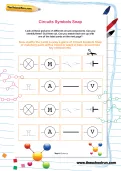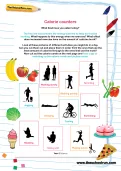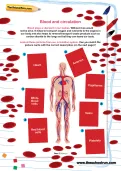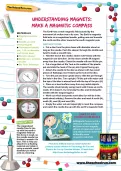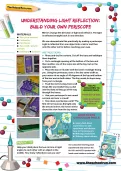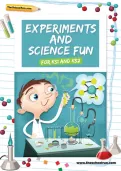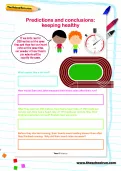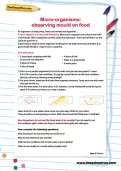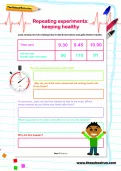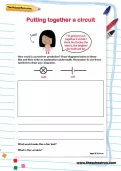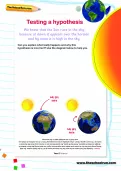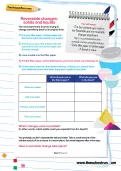Year 6 Science worksheets
Free worksheets: Science, KS2, Y6
You’ll need to login or Register first to access these worksheets for free.
Once you’ve tried out our free worksheets, why not explore all our resources (1000s of worksheets, interactive tutorials, learning packs and more) with a 14-day FREE trial subscription.
What stores and transfers energy?
Energy cannot be created or destroyed, it can only be transferred from one store into another. In these pictures, which items do you think use energy? Which ones store energy? Do they all store/use the same type of energy? Cut them out and sort them into groups.
Understanding friction: Build your own balloon hovercraft
When a moving surface slides on a stationary surface it rubs against it, which slows it down. This is due to friction, a force which resists the movement of one object sliding past another. Understand more about friction with a fantastic practical project: make your own balloon hovercraft!
Super scientist quiz
Quiz questions to encourage your child to think about how scientists work and why they do the things they do.
Reaching conclusions
A worksheet showing results of an experiment with questions underneath to consider.
Micro-organisms investigation
This investigation will help you find out which conditions will encourage micro-organisms such as mould to grow.
Label a human eye
Look at this diagram of the eye. Do you recognise all the different parts? Use the labels below to finish off the diagram.
How fast do you breathe?
We breathe all of the time. Breathing is vital to ensure that oxygen is taken into our bodies and harmful carbon dioxide is taken out of our body… but how fast do we breathe? When does this change? Why? Complete the table and see if this helps you to answer these questions.
Heart rate mix and match
When we exercise the muscles and organs in our body need more oxygen and energy. Our heart therefore has to work much harder. Look at these pictures of different activities. Can you cut out the pictures and the heart rate cards and match up each activity with the heart rate you think is correct?
Habitat adaptation
Plants, just like animals, are able to adapt to their environment – they have to do this to survive. Sometimes this is a short-term change; they can also evolve to change permanently. This investigation looks at how plants adapt to meet their need for light.
Fatty foods investigation
Ask an adult to help you select different foods that you think may contain more fat than others. Carefully rub each food in turn in one of the circles. Label each circle so that you can see which food was in which circle. Leave the paper to dry. When dry hold it up to the light. You should be able to see which foods contained more oil and fat as this will be left on the paper!
Drawing circuit diagrams
Look at these cards. Can you draw circuit diagrams using the correct symbols to match these descriptions?
Circuits Symbols Snap
Look at these pictures of different circuit components. Can you identify them? Cut them out. Can you match each one up with one of the label cards on the next page? Now shuffle the cards to play a game of Circuit Symbols Snap or matching pairs with a friend or adult to help revise these key components.
Calorie counters
Look at these pictures of different activities you might do in a day. Can you cut them out and place them in order from the ones that use the least amount of calories through to the ones that use the most?
Blood and circulation
Look at these pictures from our circulation system. Can you match the picture cards with the correct description?
Understanding magnets: Make your own magnetic compass
The Earth has a weak magnetic field caused by the movement of molten iron in its core. The Earth’s magnetic field acts on a magnetised needle, pulling one end towards the north and the other towards the south magnetic pole. Understand more about magnets by making your very own magnetic compass from a polystyrene pizza base, a needle, a pin and a strong magnet.
Understanding light reflection: Build your own periscope
Mirrors change the direction of light and reflect it. We can demonstrate this practically by making a periscope. Light is reflected from one object into a mirror and then onto the other mirror before reaching your eyes. Collect your materials and find out for yourself!
Understanding friction: Build your own balloon hovercraft
When a moving surface slides on a stationary surface it rubs against it, which slows it down. This is due to friction, a force which resists the movement of one object sliding past another. Understand more about friction with a fantastic practical project: make your own balloon hovercraft!
Experiments and science fun for KS1 and KS2
Beans, gingerbread men, ice, washing-up bottles and cocoa powder – that's all you need to demonstrate key KS1 and KS2 science concepts to your child at the kitchen table. Packed with simple experiments, fun games (Muffled Chinese Whispers, anyone?) and parent-friendly science explanations, our Experiments and science fun for KS1 and KS2 learning pack is all you need to make primary science come to life for your child.
Predictions and conclusions: keeping healthy
A worksheet with predictions for an experiment into heart rates to test children on their investigative skills.
Micro-organisms: observing mould on food
A simple activity your child can carry out at home in order for them to see micro-organisms in the form of mould developing on different food types.
Repeating experiments
This worksheet shows the results of somebody who has measured their heart rate. It gives questions to prompt children to use their investigative skills.
Putting together a circuit
This worksheet encourages children to think about how they would carry out an experiment into circuits. It requires them to draw a diagram using the correct symbols.
Testing a hypothesis
A worksheet giving a hypothesis about the movements of the Sun and Earth. Children need to think about whether it is right or wrong and explain their reasoning.
Reversible changes: solids and liquids
An activity to help your child understand that some solids can be separated from liquids by filtering.
